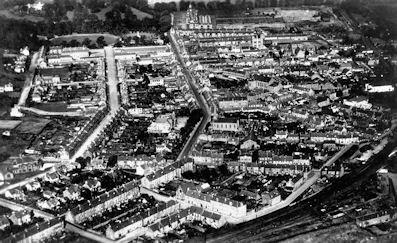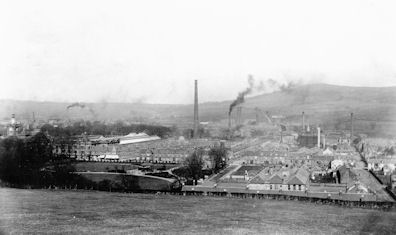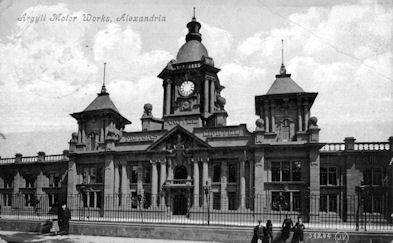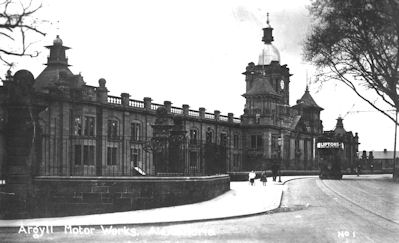Brief History of Alexandria 1800 - 2008 - Page 4
Page 1 | Page 2 | Page 3 | Page 5
The next few years saw the construction of some of the finest of Alexandria's red sandstone buildings, much of it carried out by public benefactors. In 1884, the Ewing Gilmour Institute for Men (which quickly came to be called the Gilmour Institute) was opened in Gilmour Street. It had a reading room, library, with newspapers available, a room for playing draughts and reading and meeting rooms.
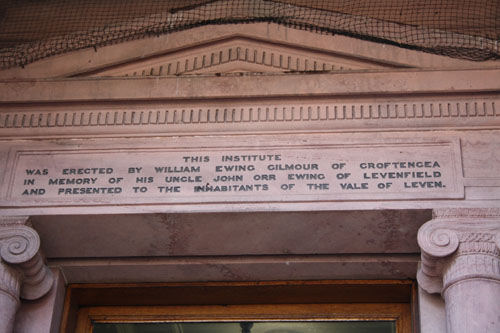
This building has played a valuable part in public life in the Vale. It has served as the head-quarters of the Parish and then the District Councils, it has housed a well-stocked library and continues as a presence for the current West Dumbartonshire council. Seven years later further up Gilmour Street, at it junction with Smollett Street, Ewing Gilmour paid for a similar Institute for women, which opened in 1891. In the event, it was largely used for functions in connection with the Scotch Girls Friendly Society, who don't seem to have been quite so friendly as anticipated because the building passed into the hands of the Masonic movement a few years later and has remained the Masonic Temple ever since.
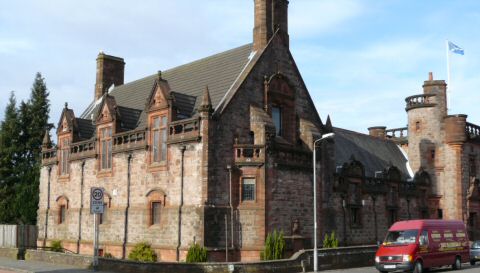
Scotch Girls Friendly Society now the Alexandria Masonic Temple
In 1893 one of the finest private buildings in the centre of Alexandria, Weir's Building, was opened at the corner of Susannah Street and Bank Street on the site of the old Devil's Elbow building, and added to the collection of fine buildings in Bank Street. This was further enhanced over the next few years by a series of imposing red sandstone buildings. First, on the opposite corner of Susannah Street from Weir's Building came Stevenson's Building (1895).
This was followed by the Co-operative Halls (1895), the Post Office (1904), and the Constitutional Club also about 1904. The Constitutional Club, which also housed the Bank of Scotland and the Parish Council Offices. The Constitutional Club did not long survive the First World War. The Conservative Party had offices in the building for many years after the demise of the Constitutional Club, until they decided to retrench to more favourable electoral territory.
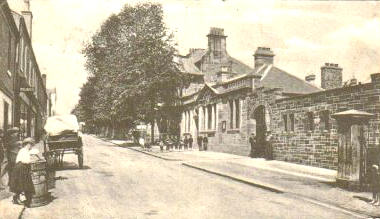
Alexandria Post Office Circa 1906
The erection of St Mungo's Episcopal Church in 1894 marked the southern boundary of buildings on Main Street Alexandria until the building of Burnbrae scheme nearly 30 years later.
Just three years after they had been “freed” both the old, narrow suspension bridges at Bonhill and Balloch were replaced with wider stronger structures, in 1898. Bonhill Bridge was replaced again in the 1990's. Balloch Bridge received a major refurbishment which closed it for many months, but it re-opened with new wide pavements and a new lease of life in 2005.
The Christie Park was opened in 1902. The laying out of the Park was a major make-over of, and extension to, an existing Park in which the Dumbartonshire Agricultural Society held its annual cattle show. It was known sometimes as Notman's Park, but increasingly known as the School Park after the North Public School was opened in 1884. The Christie Park covers approximately 13 acres and as well as well-laid out gardens, an large open play area and the woods, all of which still exist, it also had a band stand which was well used, and a pergola-type shelter.
The Park takes its name it from John Christie of Galangad (near Caldarvan) who was one of the owners of the Craft (Alexandria Works) and who is usually credited as having gifted the Park to the people of the Vale. That's not quite how his employees saw it at the time. Part of UTR workers earnings was an annual bonus. Christie, or the UTR board decided that in 1902, instead of paying the employees a bonus, they would instead take the bonus money and pay for a Park, named after John Christie. For years after you would know that someone worked in the Craft by the fact they always referred to the “Bonus” Park and never the Christie Park.
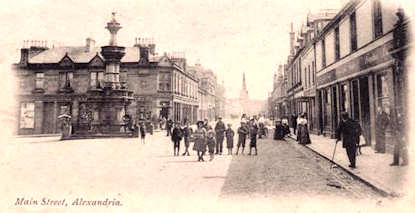
The fountain circa 1904 (from an old postcard of that time)
Almost from the day it opened it, attracted Vale Veterans, who up until this time, had strolled along Main Street to Balloch Road and back each day. They switched their loyalties to a couple of circuits of the Park and a seat in the shelter for a chat and a smoke of their pipes. They were soon being called the Christie Park Veterans and eventually they formed themselves into a club. It was therefore wholly appropriate that after the First World War, Christie Park was chosen for the site of the Vale cenotaph. The cenotaph has 363 names on it of those from Bonhill Parish who fell in the First World War, and 78 names from World War Two. Renton, which in 1919 was still in Cardross Parish for administrative purposes, quite properly built its own war memorial.
By the 1890's, most of the building of the middle of Alexandria had been completed, and it had the appearance it would keep until the 1970's. Wilson, Victoria, Albert and Middleton Streets had been completed. In Smollett Street, the red sandstone terrace and some of the villas had been built. In many of the older streets such as Alexander Street and parts of Main Street some buildings were already suffering from varying degrees of overcrowding. The major exceptions were King Edward Street, Govan Drive (named after Alexander Govan of Argyll Motors) and Argyll Street (named after Argyll Motors). These last three Streets were built by Argyll Motors to house their workers, and were finished about 1907. As with all of Argyll building, they were built to a very high standard for the time.
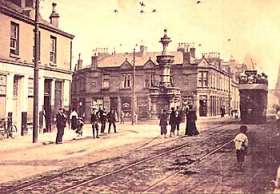
A tram passes the fountain in Alexandria
Trams arrived in Alexandria in 1907–8. There were two separate lines, which met at the Fountain. The first line was from Dalmuir to Balloch terminating in Balloch Road on the west side of Balloch Station. The tram came along from Renton on the Main Street through Alexandria and then down Balloch Road to station level crossing. These trams ran every 20 minutes in each direction. The second line went from Alexandria to Jamestown. The Fountain was the terminus and the line ran down Bank Street across Bonhill Bridge and up the Stirling road to stop at the level crossing at Jamestown station.
(See separate contribution on Trams in the Vale of Leven)
Run by a private company, the Dumbarton Burgh and County Tramways Co Ltd, the tram-way system was single-track with double-track loops every couple of hundred yards to allow converging trams to pass. The trams were open-decked on top, but passengers were not allowed to use the top deck on the Jamestown tram in case anyone stood up and decapitated themself as the tram passed under the railway bridge in Bank Street.
People from up-country - Drymen, Gartocharn etc - would come to shop in Alexandria via the Stirling line train, getting off at Jamestown station and catching the tram - the “Jimston bogie or barra or caur”, take your pick of the affectionate nick-names, all were used to describe the tram from Jamestown - to Alexandria. Trams ceased operations in 1928 because of competition from buses. Old lines were left in place to strengthen the roadways and are periodically exposed during road works. The poles which supported the overhead wires, however, were removed within few months of the closure of the service.
The story of Argyll Motors Ltd doesn't start in Alexandria, but it has certainly played a highly visible part of in the life in the Vale for the past 100 years. The story begins in Hozier Street in Bridgeton, Glasgow, when Alexander Govan, who up until then made bicycles, decided to join the increasing boom in the use of the motor car, by making Renault cars. In 1899 Govan formed Hozier Engineering, with a £15,000 investment from the National Telephone Company, and started to make cars on his own behalf, the Argylls. He was successful and Hozier was building about 10 cars a week by 1904, one of which drove from Land's End to John O'Groats in 1904 in 42 hours - a considerable achievement for those early days of automobiles and road surfaces which truth to tell probably weren't much worse than many in the area now.
Govan was an ambitious entrepreneur and he soon began to aspire to volume production of his cars. He already understood that he could steal a march on his competitors by using the latest manufacturing and engineering techniques in a volume-production factory. He also understood that the best way to achieve his manufacturing goals was in a new purpose-built factory with plenty of space to build and expand the production lines he had in mind. For this he needed a green-field site. Having searched around he decided on a site in north Alexandria in 1905.
He then did what a similar businessman would do to-day - he formed a new company to deliver his vision and issued shares in the company to raise the necessary capital. Argyll Motors Ltd was incorporated in 1905, £500,000 in share capital was raised from the financial markets and building work began on the green-field site in Alexandria in April 1905. The factory was officially opened in 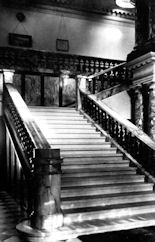 June 1906 - just 14 months later - but production had actually started some months previously.
June 1906 - just 14 months later - but production had actually started some months previously.
Getting such an innovative, and, for its time complex, factory up and running in such a short time was a remarkable achievement. If the spend on the building raised a few eyebrows - the marble staircase (click image to enlarge) and gold leaf on the dome, to mention but two of the apparent extravagances which have endured for 100 years in Vale folk-lore, the factory's approach to manufacturing and production engineering processes still look impressive to-day. On top of that, the staff facilities in terms of dedicated training areas, dining rooms, health and safety etc are just about as good as you'll find in factories being built to-day.
In communications as in many other ways it was leading edge for its day - every main room had telephones which could make external calls. The £250,000 it cost to build was certainly a big sum for the day, it was also half of the available share capital, but it was not of itself a fundamental threat to the financial well-being of the company. Indeed Argyll Motors initially prospered - it made 60 cars a week, for a time employed 2,000 men and paid dividends at the rate of 10% for the first two and a half years. However, in May 1907 Mr Govan suddenly died of a cerebral haemorrhage and the company lost its driving force.
Just over a year later in July 1908, Argyll Motors had its first financial crisis. It went into liquidation and was financially and operationally restructured. This seemed to do the trick and although the work force was reduced to about 1,300 the company seemed to prosper. Typical Argyll cars included:
- The Torpedo Car a 15 HP car - the Flying Fifteen - of 1910, which cost £445
- The Double Phaeton a 12 HP model of 1912 , which cost £335
- The Prince Henry Single-Sleeve Valve Car a 25 HP model costing £690
- Limousine-Laundaulette, again 25 HP model costing £800.
An Argyll car broke the world speed record in 1913, an event recognised by a civic reception back in Alexandria. The Argylls were seriously expensive cars for their day, but it has to be remembered it was only the well off who were buying cars anywhere in Europe at this time. There were certainly more than enough of them to buy the 3,000 cars a year which Argyll aimed to make and sell. In fact, the Alexandria factory was for a time, producing more cars than any other car factory in Europe. The mass market opened up by Henry Ford's Model T hadn't yet arrived, but because of Govan's plans and foresight, the factory he built would certainly have been ideally placed to compete in volume production to supply a mass market.
But it was not to be. In June 1914 Argyll Motors once more went into liquidation, and the Alexandria works were closed. Argyll Motors went back to the Hozier works at Bridgeton, (which had never in fact been relinquished, and which might well have contributed to their financial problems), and continued in very low volume production until 1928. For Alexandria, Argyll Motors remains the great “what if?” of its history. What if Govan hadn't died? What if Argyll Motors had staggered on for a few more weeks until the outbreak of the First World War? What if some other vehicle manufacturer had moved in rather than a munitions manufacturer who was only ever likely to be there for the duration of the War?
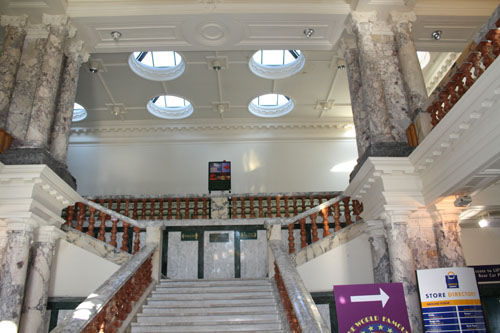
Still, Argyll Works provided employment for 1,500 people - 600 of whom commuted into the Vale by train from Glasgow every day, which was a completely new concept. It generated a considerable amount of cash in and around Alexandria for a number of years. It provided new skills for many Vale folk, which they could apply elsewhere, at least until the Depression of the 1930's set in.
One of the people it trained was John Logie Baird the inventor of television, who worked as an engineering apprentice for Argyll, as did the man whose face was the first to be transmitted on television in 1926, Oliver Hutchison. They were apprentices in Argyll at the same time and later worked together on the development of television. And it provided the the Vale with a visually pleasing building which still looks as good 100 years on as it did the day it opened, and better than just about anything that's been built anywhere in Scotland in that time.
Page 1 | Page 2 | Page 3 | Page 5

